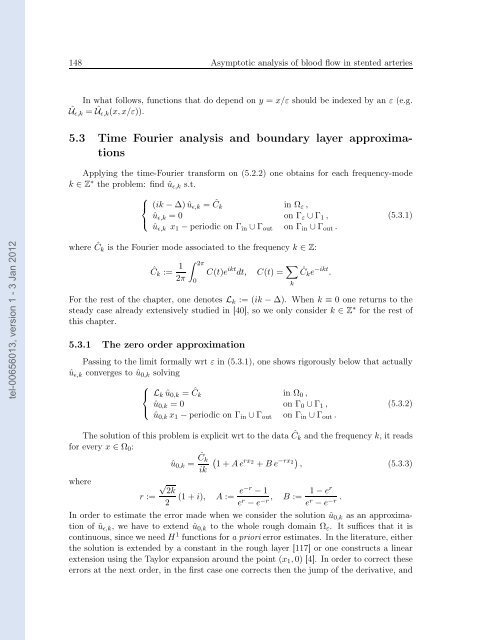Modélisation, analyse mathématique et simulations numériques de ...
Modélisation, analyse mathématique et simulations numériques de ...
Modélisation, analyse mathématique et simulations numériques de ...
You also want an ePaper? Increase the reach of your titles
YUMPU automatically turns print PDFs into web optimized ePapers that Google loves.
tel-00656013, version 1 - 3 Jan 2012<br />
148 Asymptotic analysis of blood flow in stented arteries<br />
In what follows, functions that do <strong>de</strong>pend on y = x/ε should be in<strong>de</strong>xed by an ε (e.g.<br />
Ûǫ,k = Ûǫ,k(x,x/ε)).<br />
5.3 Time Fourier analysis and boundary layer approximations<br />
Applying the time-Fourier transform on (5.2.2) one obtains for each frequency-mo<strong>de</strong><br />
k ∈ Z ∗ the problem: find ûǫ,k s.t.<br />
⎧<br />
⎨<br />
⎩<br />
(ik −∆)ûǫ,k = Ĉk<br />
in Ωε,<br />
ûǫ,k = 0 on Γε ∪Γ1,<br />
ûǫ,k x1 − periodic on Γin ∪Γout on Γin ∪Γout.<br />
where Ĉk is the Fourier mo<strong>de</strong> associated to the frequency k ∈ Z:<br />
Ĉk := 1<br />
2π<br />
C(t)e<br />
2π 0<br />
ikt dt, C(t) = <br />
Ĉke −ikt .<br />
k<br />
(5.3.1)<br />
For the rest of the chapter, one <strong>de</strong>notes Lk := (ik −∆). When k ≡ 0 one r<strong>et</strong>urns to the<br />
steady case already extensively studied in [40], so we only consi<strong>de</strong>r k ∈ Z ∗ for the rest of<br />
this chapter.<br />
5.3.1 The zero or<strong>de</strong>r approximation<br />
Passing to the limit formally wrt ε in (5.3.1), one shows rigorously below that actually<br />
ûǫ,k converges to û0,k solving<br />
⎧<br />
⎨<br />
⎩<br />
Lkû0,k = Ĉk<br />
in Ω0,<br />
û0,k = 0 on Γ0 ∪Γ1,<br />
û0,kx1 − periodic on Γin ∪Γout on Γin ∪Γout.<br />
(5.3.2)<br />
The solution of this problem is explicit wrt to the data Ĉk and the frequency k, it reads<br />
for every x ∈ Ω0:<br />
û0,k = Ĉk rx2 −rx2 1+Ae +Be<br />
ik<br />
, (5.3.3)<br />
where √<br />
2k<br />
r :=<br />
2 (1+i), A := e−r −1<br />
er 1−er<br />
−e−r, B :=<br />
er .<br />
−e−r In or<strong>de</strong>r to estimate the error ma<strong>de</strong> when we consi<strong>de</strong>r the solution û0,k as an approximation<br />
of ûǫ,k, we have to extend û0,k to the whole rough domain Ωε. It suffices that it is<br />
continuous, since we need H1 functions for a priori error estimates. In the literature, either<br />
the solution is exten<strong>de</strong>d by a constant in the rough layer [117] or one constructs a linear<br />
extension using the Taylor expansion around the point (x1,0) [4]. In or<strong>de</strong>r to correct these<br />
errors at the next or<strong>de</strong>r, in the first case one corrects then the jump of the <strong>de</strong>rivative, and

















